The discovery of a new form of elemental carbon 20 years ago changed thinking in chemistry. Philip Ball investigates whether the buckyball has lived up to the hype and what legacy it has left
The discovery of a new form of elemental carbon 20 years ago changed thinking in chemistry. Philip Ball investigates whether the buckyball has lived up to the hype and what legacy it has left
On a September morning in Texas, US, 20 years ago, Harry Kroto looked at a printout of his latest experimental data and scribbled onto it a little piece of innocuous jargon. He wrote ’C60+?’ Eleven years later, that ’C60+’ won Kroto and his collaborators in Houston, US, a Nobel prize.
But C60 - the football-shaped carbon molecule that represented an entirely new form of this most familiar of elements - did much more than that. It appeared on the covers of journals and in national newspapers. Books were written about it, and it featured in science-fiction novels. It was Science magazine’s molecule of the year in 1991. It drew praise for its beauty, its elegance, its perfect symmetry. During the 1990s, C60, christened buckminsterfullerene but nicknamed the buckyball, was chemistry’s superstar, and for several heady years it promised to make chemistry sexy again.

Few superstars, however, sustain a 20-year career, and C60 is no exception. Sceptics might be inclined to ask: where it is now? Has this great round hope of chemistry fulfilled any of its expectations? Was all the fuss and hype warranted? What legacy has it left?
Yet we should really ask not so much what C60 means today as where it led. On the one hand, it has not (so far) found any major applications, and even in the specialist journals its profile has declined. But on the other hand, the influence of C60 is now pervasive in chemistry and beyond. The buckyball put the nano into nanochemistry. At about a nanometre across, it is the ideal nanoscale building block, a kind of super-atom that can be picked up and manipulated with nanotechnological tools. It has rearranged our view of carbon science, opening up a perspective in which the flat sheets of carbon atoms in graphite can be bent, twisted and curled into all manner of shapes. Kroto says that he takes greatest pride from the fact that ’C60 explains most aspects of carbon’s nanoscale structure’. The most notable representatives of this nanoworld, carbon nanotubes, are now becoming the centrepiece of nanotechnology, promising (and it’s no longer just a promise) everything from new strong materials to molecular-scale electronics.
At first sight
The printout on which Kroto first scribbled ’C60’ was a mass spectrum: a plot of the masses of clusters of carbon atoms produced by zapping a piece of graphite with a laser beam, in an instrument developed by the late Richard Smalley at Rice University, Houston (see p8). Smalley was mainly studying clusters of semiconducting materials, but Kroto, based at the University of Sussex, UK, was interested in the carbon molecules formed in the atmospheres around carbon-rich red giant stars, several of which he and others had identified in stellar spectra. These molecules contained chains of carbon atoms, and Kroto believed Smalley’s machine might supply a way of making particularly long ones. He was introduced to Smalley by Robert Curl, a fellow spectroscopist also at Rice.
The researchers found that the relative abundance of small carbon clusters produced this way had a peak at 60-atom clusters. What was more, successive clusters differed in mass by that of two carbon atoms: they contained only even numbers of atoms.
The laser-ablation apparatus was operated by Smalley’s students Jim Heath and Sean O’Brien, along with Yuan Liu and Qing-Ling Zhang. They found very quickly that the 60-atom peak, corresponding to the C60 cluster, was often much stronger than any of the others, and the students tinkered with the settings until, on 4 September, they produced a mass spectrum in which C60 soared above the rest. They noted that the C70 peak was also very strong.
When Kroto, Smalley and Curl gathered to discuss the findings, they realised that there must be something special about a C60 cluster. This was confirmed when, several days later, Heath and his colleagues managed to generate spectra in which C60 stood virtually alone, like a flagpole, accompanied only by its ever-present sidekick C70. ’I think I was probably the first person to see C60 in a machine,’ says Heath. ’I was a little na?ve at the time - I thought this happened a lot.’
The story has been told often enough now of how Kroto and colleagues puzzled over cut-out pieces of paper, toothpicks and gummy sweets, and images of US architect Richard Buckminster Fuller’s geodesic domes, until they figured out that 20 hexagonal and 12 pentagonal rings of carbon atoms can be linked into a spherical shape with 60 carbon atoms at each identical vertex. The resulting hollow carbon cage has icosahedral symmetry - technically, it is a truncated icosahedron - and the high symmetry of this closed-shell form lends it particular stability.
A C70 cage can be constructed by adding extra hexagons around the equator to form an elongated shape crudely reminiscent of a rugby ball. Creating or removing edges from the cage by changing the number of pairs of carbon atoms produces a whole menagerie of carbon-shell molecules: the fullerenes.
The boldness of the idea lay in the notion that carbon atoms in the vapour formed by laser ablation could spontaneously join together in such a seemingly complex arrangement. That was one reason why, when Kroto and colleagues published their results in Nature along with the proposed structure of C60, many researchers were sceptical. ’The first five or six papers after that said we were wrong,’ Kroto says. ’It was a real struggle over the next five years,’ Heath agrees. ’We were looking at maybe a hundred molecules at a time, working our tails off to prove that what we had was right.’
It wasn’t until 1990, when Donald Huffman in Arizona, US, Wolfgang Kr?tschmer in Heidelberg, Germany, and their co-workers made large quantities of C60 using a simpler method of electric-arc-discharge vaporisation of graphite rods, that it became possible to verify the structure using x-ray diffraction. This efficient means of preparing buckyballs ’was a surprise to the whole chemistry community,’ Kroto says. ’Kr?tschmer and Huffman were physicists - they didn’t have the hang-ups that chemists had.’
What use is it?
A means of mass-producing C60 crystallised the question that until then had been little more than a chemists’ parlour game: what use is it? Indeed, the molecule became so famous in the wake of the breakthrough by Huffman and Kr?tschmer that the question was even raised in the British House of Lords. The rather dry and technical answer provided on that occasion led Lord Russell to ask ’Can one say that it does nothing in particular and does it very well?’ ’That may well be the case,’ Lord Reay conceded.
Kroto hoped it might do rather better than that. He had speculated in the late 1980s that its spherical shape, combined with its graphitic nature, might make C60 a particularly good lubricant, the C60 molecules acting like nano-ball-bearings. But that didn’t prove to be the case. Silicon coated with a C60 film, for example, has higher friction than bare silicon. In retrospect that wasn’t surprising, Kroto explains - for as engineers know (he, like many chemists, initially did not), graphite lubricates not by the sliding of its carbon sheets but by the release of intercalated gases.
Nevertheless, in 1996 Jacob Israelachvili and co-workers at the University of Santa Barbara in California, US, found that C60 does seem to have lubricating properties in liquids. When one or two layers were adsorbed onto solid surfaces immersed in a liquid, the drag on the surface was almost eliminated, showing that the fluid could slip past it freely. So C60 could be useful as a drag-resistant additive. Israelachvili says that his student on that project, Sam Campbell, is now working for a Texas company that adds C60 as a drag reductant to light fuels and oils, but that the whole operation is proprietary and shrouded in secrecy.
Kroto was also excited by the idea that C60 might usher in what he called ’round chemistry’: if its surface was reactive, organic chemists might be able to build outwards in three dimensions. Sure enough, they soon found ways of attaching functional groups to the carbon ball: as many as 36 fluorine atoms have been stuck on, for example, although that makes the molecule highly non-spherical and so puts paid to any notions of Teflon nano-bearings.
Attractive for drug development
Various biomedical uses of these C60 derivatives have been proposed, including anti-HIV drugs, bone-disorder drugs and antibiotics - but none has yet made an impact in the pharmaceutical world. Lon Wilson of Rice University sees C60 as an attractive molecule for drug development because it provides a three-dimensional scaffolding to which various drug molecules might be tethered, creating complex cocktails in a kind of single-molecule pill. ’C60 is like a molecular pincushion,’ Wilson says. Among the drug agents that he and his colleagues have pinned to it is the anti-cancer drug taxol. Recently they have shown that, encapsulated in liposomes, the conjugate delivers a slow release of taxol as the linkage is hydrolysed. ’Taxol tethered to C60 is not a drug until that linker is broken,’ says Wilson. He believes that this compound might be effective in treating lung cancer, for which such liposomes could be administered in an aerosol spray.
Another arena in which C60 compounds have proved promising is in solar power. C60 is a good electron acceptor, and has been used as an element of molecular assemblies that are designed to mimic the early steps of photosynthesis. Devens Gust and co-workers at Arizona State University have made various ’molecular triads’: three-component molecules in which absorption of light by the central component causes an electron to be shifted to an acceptor at one end and removed from an electron donor at the other end. This separation of positive and negative charge imitates the processes that happen in photosynthetic reaction centres, and might lead to a new way of harvesting energy from sunlight. ’The secret of success here is the electron-withdrawing property of the carbon cage,’ says Roger Taylor at the University of Sussex, a pioneer of fullerene chemistry. He points out that solar-cell devices that use C60 as an electron acceptor so far have efficiencies of three per cent. ’This has be to raised to seven to eight per cent to compete with current silicon ones,’ he admits. The ability of C60 to capture electrons also makes it a useful additive for improving the performance of polymer-based solar cells, which researchers are now hoping to manufacture cheaply with vast areas.
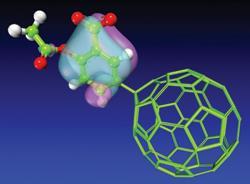
’There have been some interesting breakthroughs in uses of C60 just in the past few months’, Kroto says, citing in particular the discovery that it is an excellent projectile for knocking large molecules and biomolecules off surfaces to mobilise them for analysis by secondary ion mass spectrometry. ’It doesn’t break the molecules up,’ says Kroto, ’because the energy is dissipated evenly’. Nick Winograd at Pennsylvania State University in the US and John Vickerman at Manchester University, UK, have been pioneering this trick for characterising delicate molecules.
Molecular metal
It wasn’t just chemists who got excited by C60. Physicists realised that it could have interesting electronic properties too. In late 1990, Robert Haddon, then at AT&T Bell Laboratories in New Jersey, US, reasoned that a crystal lattice of graphite-like carbon balls ought to be electrically conducting, with charge carriers hopping from ball to ball. To provide charge carriers in the first place, he speculated that C60 crystals might be doped with alkali metals. When Haddon and his colleagues tried this in early 1991, they found that indeed alkali-metal-doped C60 was a good conductor: a kind of molecular metal.
But it got far better than that. Only weeks later, they discovered that when these doped crystals were cooled, they became superconducting at 18K - an amazingly high temperature for an organic superconductor. In fact, Cs2RbC60 proved to have a superconducting transition temperature of 33K - an unheard-of record for anything other than the copper-oxide high-temperature superconductors discovered in the mid-1980s. ’At the start, almost everything was surprising about C60,’ Kroto says. Soon, physics journals were filled with papers trying to understand this behaviour, and making predictions about how far the temperature could be raised.
Haddon now admits that these properties didn’t lead to any applications in electronics. But he feels that there was real value for fundamental science. ’I believe the fullerenes contributed a great deal to molecular solid state sciences,’ he says. ’The ability of the molecule to be doped to a metal, which in some cases is a superconductor, and back to an insulator is quite unique.’
Probably the most fertile avenue of C60 research was as much a piece of serendipity as the original discovery. When Kr?tschmer and Huffman reported C60 mass synthesis by arc evaporation of graphite, electron microscopist Sumio Iijima at the NEC Corporation in Japan was already on the same track, because he had long been interested in the carbon structures formed by this procedure. On varying the Kr?tschmer-Huffman process, he found in 1991 that he could make long, tubular fullerenes with a concentric-shell structure, a few nanometres wide and capped with C60-like hemispheres or faceted tips. These became known as carbon nanotubes, and they are now the main focus of carbon nanoscience. They appear to be extremely strong and stiff fibres, and they are electrically conducting (either metallic or semiconducting, depending on their precise structure).
Nanotubes show promise
Single-walled nanotubes have been used to fashion single-molecule electronic devices such as transistors, and as researchers grow more adept by the week at growing nanotubes exactly where they want them on a surface, the prospect of nanotube-based circuitry, far smaller than anything that can be made with conventional microchip fabrication methods, is starting to look ever more plausible.
As ultra-strong fibres, carbon nanotubes have yet to prove their worth - the key problem is that it is hard to grow them to very long lengths. But they have produced fabrics made from tangled mats of tubes, such as tough fibrous sheets (’bucky paper’) and transparent, electrically conducting films. The latter, unveiled last August by Ray Baughman and co-workers at the University of Texas at Dallas, US, can be reeled out at 10 metres a minute into a ribbon just 50nm thick, and might find a use in ultra-thin electronic displays.
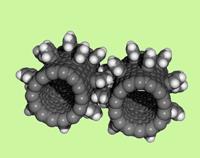
Very recently, C60 itself proved its worth for materials scientists. It has been known for several years that C60 crystals can, like graphite, be transformed into diamond by high temperature and pressure. But last August, Natalia Dubrovinskaia from the University of Bayreuth in Germany and colleagues reported that when they crushed C60 crystals under 200 000 atmospheres pressure at 2500K, the material became transformed into a diamond-like substance composed of many wire-like crystals, which they called aggregated diamond nanowires. This substance is the hardest known - even exceeding the hardness of diamond, it can scratch a diamond surface.
There’s still plenty of time for applications of C60 to appear, and no shortage of interest. ’The last I heard, there are about 150 products being investigated or developed,’ says Taylor. Appropriately enough, the first commercial product is a C60-coated bowling ball, which its manufacturers, ABS in Japan, claim has very low wear. ’Presumably this is due to the lack of compressibility of C60,’ says Taylor. ’There are also titanium-C60 golf club heads, which presumably benefit from the same property.’ ABS’s C60-coated balls have captured 70 per cent of the Japanese bowling ball market; they call them Nanodesu, which is Japanese for ’It’s nano’.
Counting on it
That seems fair enough, for Jim Heath credits C60 as one of the key stimuli that drew chemists to nanotechnology. Just at the time that developments in physics, particularly the invention of the scanning tunnelling microscope (STM) and its relatives, were making the nanoscale accessible, he says, ’C60 came in and illustrated the power of chemistry at this new length scale’.
That potential was most graphically illustrated in 1996, when Jim Gimzewski, then working at IBM’s research labs in Z?rich, Switzerland, unveiled a ’molecular abacus’ in which C60 molecules were the beads and the STM provided the fingertip. ’We had 10 buckyballs in a row,’ says Gimzewski, ’and then we came down with a tip and nudged one to the side’. And then another, and another, until the IBM team showed that they could shift the whole row, one molecule at a time. ’It stirred up some amazing interest,’ Gimzewski says. ’It was in the Guinness Book of Records as the world’s smallest calculator.’
Of course, this was never going to be a practical way to do computing. But that was not the point, according to Gimzewski. ’It helped to change the mindset. It said, we can take single molecules and do what we want with them. Those experiments helped to make the idea of nanotechnology somewhat tangible, something that was achievable.’
One of the most enticing features of C60 as a nanoscale object is that it lies on the threshold of the quantum and classical worlds. It is big enough to see in an electron microscope, and yet small enough that it can be considered a quantum object. That point was emphasised in 1999 when Anton Zeilinger and his colleagues at the University of Vienna in Austria showed that C60 molecules truly possess wave-like properties. The researchers directed a beam of C60 molecules through a diffraction grating with a periodicity of 100nm and saw a resulting interference pattern. This makes C60 the largest entity for which wave-particle duality has been observed. Perhaps that is appropriate for a molecule that at first seemed so elusive.
Philip Ball is consultant editor for Nature, 4-6 Crinan Street, London N1 9XW.



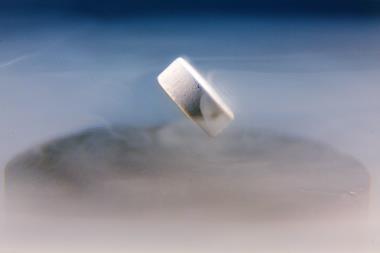


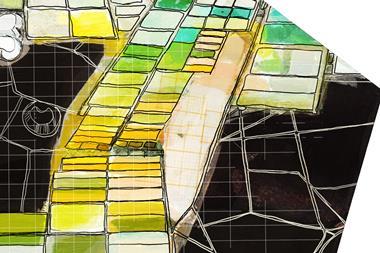
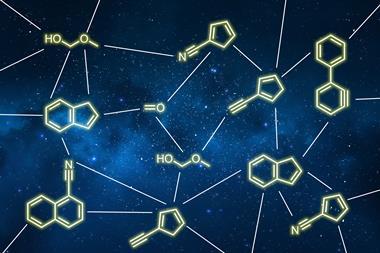

No comments yet